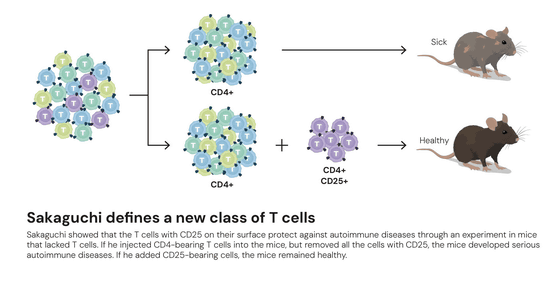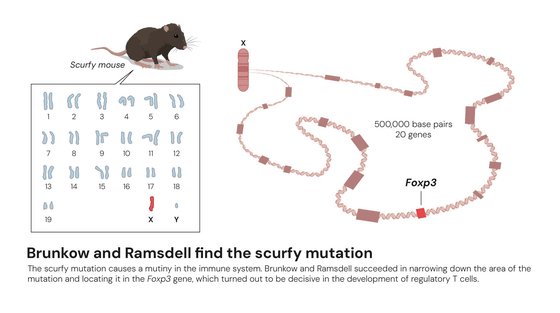What are 'regulatory T cells' discovered by a Japanese researcher who won the 2025 Nobel Prize in Physiology or Medicine?

by
The Nobel Committee at Sweden's Karolinska Institute has announced that the 2025 Nobel Prize in Physiology or Medicine will be awarded to Mary Brankow of the Institute for Systems Biology in the United States, Fred Ramsdell of the biotechnology company Sonoma Biotherapeutics, and Professor Shimon Sakaguchi of Osaka University. The award is for their 'discoveries into peripheral immune tolerance,' in recognition of their discovery and research into regulatory T cells . Lydia Becker, Director of the Institute of Immunology and Inflammation at the University of Manchester, explains regulatory T cells.
Nobel prize awarded for discovery of immune system's 'security guards'
https://theconversation.com/nobel-prize-awarded-for-discovery-of-immune-systems-security-guards-266833
Medicine Nobel goes to scientists who revealed secrets of immune system 'regulation'
https://www.nature.com/articles/d41586-025-03193-3#ref-CR3
The immune system is essential for maintaining our health by regulating tissue growth, removing old cells and waste products, and eliminating dangerous viruses and bacteria. However, while the immune system attacks invaders such as viruses and bacteria, it must maintain a delicate balance, avoiding accidentally attacking our own tissues. When this balance is disrupted, autoimmune diseases such as type 1 diabetes, rheumatoid arthritis, and multiple sclerosis can occur.
For many years, scientists have been unable to fully understand the mechanisms of 'immune tolerance,' the ability of the immune system to tolerate its own tissues. While it has been speculated for decades that the immune system has a 'brake'-like function that inhibits itself, this mechanism has not been proven.
In 1995, Professor Sakaguchi discovered that among T cells, a type of lymphocyte that controls the immune system, there exists a type called 'regulatory T cells' that have a specific type of protein on their surface.
Immunologic self-tolerance maintained by activated T cells expressing IL-2 receptor alpha-chains (CD25). Breakdown of a single mechanism of self-tolerance causes various autoimmune diseases - PubMed
https://pubmed.ncbi.nlm.nih.gov/7636184/
Regulatory T cells are immune cells that play a very important role in monitoring and suppressing the immune system so that it does not mistakenly attack the body. Although regulatory T cells account for only 1-2% of all T cells, they have the ability to rush to sites where immune reactions are occurring, calm excessive reactions, and effectively suppress inflammation.
In experiments using mice, Professor Sakaguchi showed that mice lacking regulatory T cells developed autoimmune diseases, but that administering these cells halted the progression of the disease. This shows that regulatory T cells eliminate harmful T cells that cause autoimmune diseases.

This discovery was initially met with skepticism from the scientific community, but in 2001, Brancow and Ramsdell discovered that regulatory T cells prevent immune cells from attacking the body by secreting immunosuppressive proteins and directly sending anti-inflammatory signals.
Brankow and Ramsdell then discovered a specific protein, FOXP3, that identifies these regulatory T cells, and found that mutations in the FOXP3 gene cause a fatal autoimmune disease in both mice and humans.

© The Nobel Committee for Physiology or Medicine. Ill. Mattias Karlén
'It took a huge amount of work at the molecular level to get to the FOXP3 mutation because it's a tiny genetic change that causes a huge change in the immune system. It took a lot of different minds working together,' Brankow said in a phone call from the Nobel Prize Committee announcing the award.
First Reactions | Mary Brunkow, Nobel Prize in Physiology or Medicine 2025 | Telephone interview - YouTube
Furthermore, in 2003, Professor Sakaguchi's research group identified that a gene called Foxp3 is specifically expressed only in regulatory T cells and is essential for the normal development and function of these cells. This discovery determined the true nature of regulatory T cells at the molecular level, whose existence had previously been suggested but whose exact nature had remained elusive.
Control of regulatory T cell development by the transcription factor Foxp3 - PubMed
https://pubmed.ncbi.nlm.nih.gov/12522256/
Previous research has shown that people with autoimmune diseases such as type 1 diabetes, rheumatoid arthritis, and multiple sclerosis often have a deficiency of regulatory T cells in their blood or they are not functioning properly, and major pharmaceutical companies are already investing in the development of drugs that stimulate regulatory T cells.
'Their discovery is crucial for understanding how the immune system works and why not everyone develops serious autoimmune diseases,' said Ole Kampe, chairman of the Nobel Prize Committee.
The audio of the phone call when Professor Sakaguchi received the news of his award is available below.
First Reactions | Shimon Sakaguchi, Nobel Prize in Physiology or Medicine 2025 | Telephone interview - YouTube
Related Posts:







